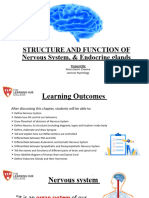0 ratings0% found this document useful (0 votes)
45 viewsBrain Brief Synapse Final
Brain Brief Synapse Final
Uploaded by
veerraju tvThe synapse is the small gap between neurons where neurotransmission occurs, allowing brain cells to communicate. There may be as many as 150 trillion synapses in the human brain. At the synapse, neurotransmitters are released from the presynaptic neuron and received by receptors on the postsynaptic neuron, transmitting signals between cells and enabling processes like learning and memory. While tiny at 20-40 nanometers wide, synapses allow for bidirectional communication between neurons that is critical to cognitive functions.
Copyright:
© All Rights Reserved
Available Formats
Download as PDF, TXT or read online from Scribd
Brain Brief Synapse Final
Brain Brief Synapse Final
Uploaded by
veerraju tv0 ratings0% found this document useful (0 votes)
45 views2 pagesThe synapse is the small gap between neurons where neurotransmission occurs, allowing brain cells to communicate. There may be as many as 150 trillion synapses in the human brain. At the synapse, neurotransmitters are released from the presynaptic neuron and received by receptors on the postsynaptic neuron, transmitting signals between cells and enabling processes like learning and memory. While tiny at 20-40 nanometers wide, synapses allow for bidirectional communication between neurons that is critical to cognitive functions.
Original Description:
brain synapses
Copyright
© © All Rights Reserved
Available Formats
PDF, TXT or read online from Scribd
Share this document
Did you find this document useful?
Is this content inappropriate?
The synapse is the small gap between neurons where neurotransmission occurs, allowing brain cells to communicate. There may be as many as 150 trillion synapses in the human brain. At the synapse, neurotransmitters are released from the presynaptic neuron and received by receptors on the postsynaptic neuron, transmitting signals between cells and enabling processes like learning and memory. While tiny at 20-40 nanometers wide, synapses allow for bidirectional communication between neurons that is critical to cognitive functions.
Copyright:
© All Rights Reserved
Available Formats
Download as PDF, TXT or read online from Scribd
Download as pdf or txt
0 ratings0% found this document useful (0 votes)
45 views2 pagesBrain Brief Synapse Final
Brain Brief Synapse Final
Uploaded by
veerraju tvThe synapse is the small gap between neurons where neurotransmission occurs, allowing brain cells to communicate. There may be as many as 150 trillion synapses in the human brain. At the synapse, neurotransmitters are released from the presynaptic neuron and received by receptors on the postsynaptic neuron, transmitting signals between cells and enabling processes like learning and memory. While tiny at 20-40 nanometers wide, synapses allow for bidirectional communication between neurons that is critical to cognitive functions.
Copyright:
© All Rights Reserved
Available Formats
Download as PDF, TXT or read online from Scribd
Download as pdf or txt
You are on page 1of 2
BRAIN BRIEFS
Neurotransmission: The Synapse
The brain is responsible for every thought, feeling, and Current estimates are listed somewhere around 0.15
action. But how do the billions of cells that reside in the quadrillion synapses—or 150,000,000,000,000
brain manage these feats? synapses.
They do so through a process called neurotransmission. What is synaptic transmission?
Simply stated, neurotransmission is the way that brain cells
communicate. And the bulk of those communications Generally speaking, it’s just another way to say
occur at a site called the synapse. Neuroscientists now neurotransmission. But it specifies that the communication
understand that the synapse plays a critical role in a occurring between brain cells is happening at the synapse
variety of cognitive processes—especially those involved as opposed to some other communication point. One
with learning and memory. neuron, often referred to as the pre-synaptic cell, will
release a neurotransmitter or other neurochemical from
What is a synapse? special pouches clustered near the cell membrane called
synaptic vesicles into the space between cells. Those
The word synapse stems from the Greek words molecules will then be taken up by membrane receptors on
“syn” (together) and “haptein” (to clasp). This might make the post-synaptic, or neighboring, cell. When this message
you think that a synapse is where brain cells touch or is passed between the two cells at the synapse, it has the
fasten together, but that isn’t quite right. The synapse, power to change the behavior of both cells. Chemicals
rather, is that small pocket of space between two cells, from the pre-synaptic neuron may excite the post-synaptic
where they can pass messages to communicate. A single cell, telling it to release its own neurochemicals. It may tell
neuron may contain thousands of synapses. In fact, one the post-synaptic cell to slow down signaling or stop it all
type of neuron called the Purkinje cell, found in the brain’s together. Or it may simply tell it to change the message a
cerebellum, may have as many as one hundred thousand bit. But synapses offer the possibility of bi-directional
synapses. communication. As such, post-synaptic cells can send back
their own messages to pre-synaptic cells—telling them to
How big is a synapse? change how much or how often a neurotransmitter is
released.
Synapses are tiny—you cannot see them with the
naked eye. When measured using sophisticated tools,
scientists can see that the small gaps between cells is
approximately 20-40 nanometers wide. If you consider
that the thickness of a single sheet of paper is about
100,000 nanometers wide, you can start to understand
just how small these functional contact points between
neurons really are. More than 3,000 synapses would fit in
that space alone!
How many synapses are in the human brain?
The short answer is that neuroscientists aren’t exactly
sure. It’s very hard to measure in living human beings. But
current post-mortem studies, where scientists examine the
brains of deceased individuals, suggest that the average
male human brain contains about 86 billion neurons. If
each neuron is home to hundreds or even thousands of
synapses, the estimated number of these communication
points must be in the trillions.
www.dana.org
You might also like
- Technical Circular FullDocument1,506 pagesTechnical Circular FullAvinash Sahu100% (5)
- MigraineDocument20 pagesMigraineveerraju tvNo ratings yet
- The Man Who Mistook His Wife For A Hat NotesDocument10 pagesThe Man Who Mistook His Wife For A Hat Notesmrquockie73% (11)
- UntitledDocument369 pagesUntitledveerraju tvNo ratings yet
- Neurotransmission: The Synapse: What Is Synaptic Transmission?Document2 pagesNeurotransmission: The Synapse: What Is Synaptic Transmission?devdsantoshNo ratings yet
- SynapsesDocument5 pagesSynapsesPaul Andrei PaguintoNo ratings yet
- Bio ProjectDocument2 pagesBio ProjectNeha SinghNo ratings yet
- Alde Annieska Learning Journal 2Document5 pagesAlde Annieska Learning Journal 2Maria AnnieskaNo ratings yet
- SynapseDocument12 pagesSynapseSweety DhillonNo ratings yet
- Roleplay Neurobiology Synapse InfosheetDocument3 pagesRoleplay Neurobiology Synapse InfosheetNoa GodinNo ratings yet
- (English) The Nervous System, Part 3 - Synapses! - Crash Course A&P #10 (DownSub - Com)Document8 pages(English) The Nervous System, Part 3 - Synapses! - Crash Course A&P #10 (DownSub - Com)bank townNo ratings yet
- Neural SignalingDocument18 pagesNeural Signaling2310715052No ratings yet
- The Processing & Information at Higher Levels: Tutik ErmawatiDocument19 pagesThe Processing & Information at Higher Levels: Tutik ErmawatiApsopela SandiveraNo ratings yet
- Intro Animal Physiology Ch-2.1Document97 pagesIntro Animal Physiology Ch-2.1Jojo MendozaNo ratings yet
- COGNITIVE PSYCHOLOGY-Midterm Assignment (Macalagay)Document8 pagesCOGNITIVE PSYCHOLOGY-Midterm Assignment (Macalagay)EsrahNo ratings yet
- Drugs and The BrainDocument7 pagesDrugs and The Brainebola123No ratings yet
- Biological Basis of BehaviorDocument44 pagesBiological Basis of BehaviorAarohi PatilNo ratings yet
- Comparative Anatomy of Brain in Vertebrates PPT IDocument26 pagesComparative Anatomy of Brain in Vertebrates PPT Isalve balasahebNo ratings yet
- SynapseDocument7 pagesSynapseSinan Sa100% (1)
- 10nervous System 1Document26 pages10nervous System 1Jack OneNo ratings yet
- Lecture - Synaptic Transmission and Neurotransmitters 06 09 2024Document53 pagesLecture - Synaptic Transmission and Neurotransmitters 06 09 2024sarahnakato439No ratings yet
- CNS NoteDocument203 pagesCNS NoteAhmad Khair Ahmad BazliNo ratings yet
- Structure and Function of Nervous SystemDocument58 pagesStructure and Function of Nervous SystemFUN FLARE SHADOWNo ratings yet
- Histo Nerv.Document43 pagesHisto Nerv.jothamkuziNo ratings yet
- Pre-Ielts reading 4Document8 pagesPre-Ielts reading 4merelyrikiNo ratings yet
- Nervous SystemDocument83 pagesNervous SystemAdéọlá OnasanyaNo ratings yet
- General Physiology of SynapsesDocument30 pagesGeneral Physiology of SynapsesSanchezNo ratings yet
- Nervous CoordinationDocument2 pagesNervous CoordinationParty CularNo ratings yet
- Physiological Psychology - 1Document35 pagesPhysiological Psychology - 1Ersin Emre BaydarNo ratings yet
- AsdfgDocument28 pagesAsdfgrerereNo ratings yet
- THE Nervous System: Biology ProjectDocument8 pagesTHE Nervous System: Biology ProjectAravind JChandranNo ratings yet
- Unit 3Document20 pagesUnit 3Imtiaz choudharyNo ratings yet
- Psy121 - Psychobiological Determinants of BehaviourDocument42 pagesPsy121 - Psychobiological Determinants of BehaviourLarry UdehNo ratings yet
- Neurons and Its Function February 2014Document4 pagesNeurons and Its Function February 2014Odaine BennettNo ratings yet
- Brain Vs MindDocument8 pagesBrain Vs MindMairaNo ratings yet
- Unit-9 NERVOUS SYSTEMDocument37 pagesUnit-9 NERVOUS SYSTEMAmrita RanaNo ratings yet
- 1-Physiology of Synapses & ReceptorsDocument34 pages1-Physiology of Synapses & Receptorsnejag15138No ratings yet
- Adobe Scan Jul 05, 2023Document7 pagesAdobe Scan Jul 05, 2023souvickadhikary152No ratings yet
- SynapseDocument1 pageSynapseamorteyNo ratings yet
- This Article Is About Synapses of The Nervous System. For Other Uses, SeeDocument6 pagesThis Article Is About Synapses of The Nervous System. For Other Uses, Seeberat90No ratings yet
- 5 SynapsesDocument60 pages5 Synapsesrosario gonzalezNo ratings yet
- Neural System - 98Document13 pagesNeural System - 98krblawyerNo ratings yet
- Nervous and Endocrine SystemDocument126 pagesNervous and Endocrine SystemNimra Bashir CheemaNo ratings yet
- 9. Control and Coordination Bio 12th_1cbf2227-14f0-4aaa-b2ac-e13c76220104Document232 pages9. Control and Coordination Bio 12th_1cbf2227-14f0-4aaa-b2ac-e13c76220104gundepriti9No ratings yet
- Brains Bodies Behaviour (Psychology)Document18 pagesBrains Bodies Behaviour (Psychology)Cassia LmtNo ratings yet
- Autonomic Nervous SystemDocument11 pagesAutonomic Nervous Systemsunil patelNo ratings yet
- Part 2 Nervous SystemDocument9 pagesPart 2 Nervous SystemkyrarensburgNo ratings yet
- SYNAPS DENT FAC 6Document7 pagesSYNAPS DENT FAC 6bader.almaririNo ratings yet
- Consciousness - Engine of Reason Seat of Soul - Paul Churchland PDFDocument329 pagesConsciousness - Engine of Reason Seat of Soul - Paul Churchland PDFmassimo rossi100% (2)
- Ch 14 Biology NotesDocument118 pagesCh 14 Biology Notessaim adeelNo ratings yet
- 1 - Synapses & Synaptic Transmission (Updated)Document13 pages1 - Synapses & Synaptic Transmission (Updated)abdallaNo ratings yet
- 3 Biological Basis of BehaviorDocument25 pages3 Biological Basis of BehaviorFatima GhaniNo ratings yet
- Biology Assignment Draft Copy Minna and AishDocument7 pagesBiology Assignment Draft Copy Minna and AishAish ThangalNo ratings yet
- Nervous System (Science Assignment)Document6 pagesNervous System (Science Assignment)Emylya HasnirNo ratings yet
- Second Quarter Grade 10 - Science HANDOUT No.2 On Neurons, Reflex, Reflex Arc & Brain General Information About The Nervous SystemDocument2 pagesSecond Quarter Grade 10 - Science HANDOUT No.2 On Neurons, Reflex, Reflex Arc & Brain General Information About The Nervous SystemMartin ReaporNo ratings yet
- 4.nervous System IDocument12 pages4.nervous System IPatricia TeyeNo ratings yet
- Neurotransmitters. Study PoolDocument2 pagesNeurotransmitters. Study Poolhajarslimaoui49No ratings yet
- Bases Biologicas Del ComportamientoDocument33 pagesBases Biologicas Del ComportamientoOmar MartínezNo ratings yet
- End - Sem - For MergeDocument42 pagesEnd - Sem - For Mergeমেঘে ঢাকা তারাNo ratings yet
- Biological Relevance of Neurotransmitter ReleaseDocument12 pagesBiological Relevance of Neurotransmitter ReleaseazzaassNo ratings yet
- 脳びー最初の部分Document1 page脳びー最初の部分あやたかNo ratings yet
- Brain Creates MemoriesDocument2 pagesBrain Creates MemoriesPalmieraNo ratings yet
- Neural Structure Assignment Solution fileDocument7 pagesNeural Structure Assignment Solution fileahsanalihacker745No ratings yet
- Evaluation of First Seizure and Newly Diagnosed.4Document31 pagesEvaluation of First Seizure and Newly Diagnosed.4veerraju tvNo ratings yet
- Central Positional VertigoDocument428 pagesCentral Positional Vertigoveerraju tv100% (1)
- Neuroimage: Sheng Zhang, Chiang-Shan R. LiDocument15 pagesNeuroimage: Sheng Zhang, Chiang-Shan R. Liveerraju tvNo ratings yet
- Pilot Product Catalogue 18Document28 pagesPilot Product Catalogue 18veerraju tvNo ratings yet
- Premature Cardiovascular Disease and Brain Health in MidlifeDocument11 pagesPremature Cardiovascular Disease and Brain Health in Midlifeveerraju tvNo ratings yet
- Acute Metronidazole-Induced NeurotoxicityDocument7 pagesAcute Metronidazole-Induced Neurotoxicityveerraju tvNo ratings yet
- Vocal Techniques 2013 (Tim Marriner)Document6 pagesVocal Techniques 2013 (Tim Marriner)Emira Syaza WafaNo ratings yet
- NX CAM Setup TemplatesDocument10 pagesNX CAM Setup TemplatesCadcamnx BrasilNo ratings yet
- ITP Activity No.1Document10 pagesITP Activity No.1juencyzaltyNo ratings yet
- CampingDocument7 pagesCampingstevenspillkumarNo ratings yet
- ESE 471 Spring 2023: Homework 2Document1 pageESE 471 Spring 2023: Homework 2Rohan LakhaniNo ratings yet
- The Ant and The Dove: (Terjemahan)Document3 pagesThe Ant and The Dove: (Terjemahan)Tri YasWhily100% (1)
- Man B&W Me-Gi: Dual-Fuel, Low-Speed EngineDocument5 pagesMan B&W Me-Gi: Dual-Fuel, Low-Speed EngineCornelius Forever'n Ever0% (1)
- ChemistryDocument24 pagesChemistryedutvonline2024No ratings yet
- Class X - Basic Maths Q PDocument6 pagesClass X - Basic Maths Q PshikharlinkuNo ratings yet
- Chem 2070 Fall 2011 Homework 2Document2 pagesChem 2070 Fall 2011 Homework 2CarolynCrenetiNo ratings yet
- Lantronix Modbus Protocol UsersGuideDocument28 pagesLantronix Modbus Protocol UsersGuideJose Luis Castro AguilarNo ratings yet
- Aquaculture, UPVDocument14 pagesAquaculture, UPVRoy LamillaNo ratings yet
- Fama Homework01Document2 pagesFama Homework01Bojo FamaNo ratings yet
- BROUCHURE DANUBE COMPLETO ComprimidoDocument72 pagesBROUCHURE DANUBE COMPLETO ComprimidoAngely Alvarez AlvarezNo ratings yet
- Fact Sheet For Science and Technology Writing Day 3Document5 pagesFact Sheet For Science and Technology Writing Day 3Nicka Makayan100% (4)
- Conductímetro Sper Manual Del UsuarioDocument45 pagesConductímetro Sper Manual Del UsuarioEduardo Zunino100% (1)
- Taller 5 OkDocument22 pagesTaller 5 OkJUAN AGUDELONo ratings yet
- Baroque Art and Architecture in Central Europe (Art Ebook)Document608 pagesBaroque Art and Architecture in Central Europe (Art Ebook)sjoubert_török80% (5)
- TPS Phone ConversationDocument2 pagesTPS Phone ConversationLeah Hora Quiatzon-EspirituNo ratings yet
- ShakiDocument13 pagesShakiAnoshKhanNo ratings yet
- PH+101+Introduction+to+Philosophy Fully+CompletedDocument107 pagesPH+101+Introduction+to+Philosophy Fully+CompletedBeatrice ChunguNo ratings yet
- TT3 PDGK4304 VinaDocument4 pagesTT3 PDGK4304 VinaVina R AliyahNo ratings yet
- DPT CurriculumDocument3 pagesDPT CurriculumDr. AtiaNo ratings yet
- KDJVol33No4 KeralaDentalJournal 2Document62 pagesKDJVol33No4 KeralaDentalJournal 2Loly SinagaNo ratings yet
- Wimax Antenna Installation GuideDocument2 pagesWimax Antenna Installation GuideNoel de LeonNo ratings yet
- Ilovepdf MergedDocument1,027 pagesIlovepdf Mergedmohd.affanshariffNo ratings yet
- PT - PIWAR TEKNOLOGI INDONESIA (Compro 2020)Document26 pagesPT - PIWAR TEKNOLOGI INDONESIA (Compro 2020)YuliaNo ratings yet
- Oral Histology Lecture 1Document12 pagesOral Histology Lecture 1Mohamed Harun B. SanohNo ratings yet

































































































